- Home
- Jimmy Guieu
Polarian-Denebian War 6: Prisoners of the Past Page 3
Polarian-Denebian War 6: Prisoners of the Past Read online
Page 3
“In other words, for X hours Nagasaki and its population were suddenly thrown back 16 years into the past while the rest of the planet remained in the Present?”
“I don’t see any other explanation, Bob. And you Kato?”
He shrugged in ignorance. “The paths of understanding sometimes have limits that Wisdom advises not to cross. However, the hypothesis of my honorable colleague Kariven seems tempting… although unconventional and irrational. But what fool would dare pretend to know the mysteries of Time?”
“None of this explains how we could slip involuntarily into this Space-Time Fold,” Zavkom, the Russian biologist, objected. “Because when Nagasaki was thrown back in time for a while, we were too. We were pulled out of the Present and plunged into the Past. The scared faces of the Japanese rescue workers, when they caught us in the ruins, proves that they were complete ‘foreigners’ to our Present… just like we were to theirs. So, there was an interpenetration of our two… Presents!”
Haido and Sakawa had followed the conversation with growing stupor. Sakawa struggling to control his emotions, addressed his foreign colleagues, “Would you be kind enough to follow me to the GCSR labs? I’ll show you something that won’t fail to surprise you.”
In front of the international scientific delegates, Sakawa opened a small, metal box that he had just put on the laboratory table.
“But that’s my scintillation counter,” Dormoy turned pale.
Indeed, in the box lay the detecting instrument in the form of a big pistol with a red light near the back.
“Well, when I lost it back there I didn’t think I’d ever see it again.” Utter confusion suddenly froze his face. “Where… and when did you find it, Dr. Sakawa?”
“This instrument was a mystery to the Japanese engineers who found it in the ruins of Nagasaki… 16 years ago today!”
“But… but come on, Sakawa, I lost this scintillator around two hours ago… right after the explosion…”
“I get it, Dormoy. You lost your counter just now after the explosion of the atomic bomb. I have to agree with the views of Dr. Kariven now… that are partly confirmed by the following facts: entering the Space-Time fold, which you say was around two hours ago, was actually 16 years ago! And at that time such scintillators didn’t exist yet. However, this one was found on August 9, 1945, by a team of Japanese specialists who were searching through the ruins of our city that has since been rebuilt.”
“It’s staggering,” Kariven pondered, looking at the counter that was slightly tarnished by time. “Imagine what the fate of our plane would have been if it was right over Nagasaki at the moment of the explosion.”
“You would have been pulverized!”
“And the wreckage of our plane would have been another enigma for the Japanese investigators along with the Americans,” Professor Harrington noted. “Because in 1945, ionocruisers didn’t exist yet.”
Tagliero spoke up in English, “My specialty in nutritional biology is far away from atomic physics but I think I’m right to wonder if experimental nuclear explosions, after Hiroshima and Nagasaki, might not have contributed to this phenomenon. The 100 explosions strung out between 1945 and 1956 could have caused some kind of… Space-Time Warp. An invisible disturbance creating this Fold that Kariven proposes.”
Harrington thought for a long time before responding personally to the suggestion of his Italian colleague. “You might have put your finger on the exact cause of this phenomenon, Tagliero. I obviously can’t explain the thing rationally, but it does seem possible that the forces of nature unleashed during our experimental explosions could have influenced our Space-Time… or the Fourth Dimension. This would explain, practically speaking, the fantastic adventure we just lived through.”
“Luckily, this ‘interpenetration’ of two time periods happened at the same place but at different times,” Kato pointed out. “I mean this: Nagasaki of 1961 remained temporally unaffected by the bomb that destroyed Nagasaki in 1945. We can therefore conclude, theoretically, that the Space-Time Fold miraculously spared our present time. Otherwise the bomb of 1945 would have also destroyed the rebuilt city of 1961.”
“That is fortunate,” Harrington gasped.
The next day, the newspapers all around the world reported the stunning statements of GCSR scientists who had lived through the fantastic adventure. Reassured about the fate of Nagasaki, the people of the world breathed a sigh of relief. No atomic bomb had been launched—of this they were certain. But as for a solution to the mystery of the Space-Time Fold, nobody was able to resolve the problem with equations and present a simplified explanation to the general public.
Everyone talked about a “space warp,” of disturbance in the “curve of our local universe,” of “cracks in the Fourth Dimension,” but nobody really knew the real meaning of these expressions. The public, for the most part, was happy just knowing that “something had gone wrong with Time,” and faced with the incredible complexity of the phenomenon, it preferred not to lean too far over the unfathomable abyss of the mystery.
For 15 days, the international delegates of the GCSR performed numerous biological, chemical and psychological tests and experiments on the people of Nagasaki. The atomic physicists and geophysicists studied the soil, the subsoil, the objects and material while Kariven Robert Angelvin undertook a comparative study of the lifestyle of the Japanese who had survived the explosion of August 9, 1945.
Afterward the delegates went back to their respective countries and resumed their usual work.
Two more weeks rolled by until the end of August. In their luxurious apartment at Place Adolphe Cherioux, Yuln and Kariven—their young son Tommy being on vacation in the countryside—were finishing up an excellent lunch. Sunlight flooded the living room through the big window. Kariven lit two cigarettes, offered one to his wife and went to sit in the cushy armchair. Yuln cuddled up in his arms and smoked in silence, happy.
The telephone rang and the anthropologist picked it up. “... speaking… Oh, hello, Jenny. Yes, she’s here.”
“Hello Jenny. Well, of course I’d love to go with you. I also have some shopping to do at the Trois Quartiers.3. We’ll go together. Come pick me up in 30 or 40 minutes…”
Yuln kissed her husband and went to get dressed. On the TV screen where the show Tele-Paris had just ended appeared a pretty announcer with a sweet voice listing the evening’s program. As she passed by, Yuln was about to turn it off when the screen suddenly went blank, leaving her bent over in mid-gesture, astonished.
“A technical problem that has nothing to do with my will,” she smiled.
A few minutes later the doorbell rang. The anthropologist went to open it and stood facing his upstairs neighbor, a young painter who had set up his studio on the rooftop terrace. Tanned and disheveled, his plaid shirt unbuttoned, he looked worried. His hands were trembling a little.
“Hello, Picasso,” Kariven joked, getting along well with the young bohemian whose real name was Pierre Arnald. “Is everything all right?”
“Uh, hello Dr. Kariven. I… don’t feel so good and…”
“Well, come in. Have a cup of coffee and tell me what’s wrong.”
“I think I need a drink… or eyeglasses.”
Kariven opened the door of the bar under the TV and with a theatrical wave of his hand, presented the row of bottles. “A drink, you say? Liqueurs? Cognac? Rotgut?”
“An aperitif, please. I haven’t eaten yet.”
Kariven served him a Cinzano, which he gulped down. “So, Pierre, are you feeling better now? Tell me what…”
“I’d rather show you the thing,” the painter jumped in. “Come up to my place and… then judge for yourself and tell me whether I need an eye doctor… or a psychiatrist.”
“What the… Did you hear that dear?” he asked Yuln who had just come back into the living room wearing a gorgeous, clinging dress of emerald green plastex.
“I heard,” she smiled. “Well, let’s go and see… see what, in
fact, Monsieur Arnald?”
“You’ll see, Madame Kariven… at least I hope you will,” he frowned.
When they reached the terrace, Arnald did not take them into his studio but pointed to the magnificent view of the capital that stretched as far as the eye could see. Yuln and her husband contemplated the sight and turned back to the painter, puzzled.
“Well, I still don’t see what’s troubling you, Arnald.”
“Ser… seriously?” he was starting to panic. “You… you don’t see anything over there… northwest?”
Kariven looked in that direction then shrugged his shoulders. “Honestly, no. I don’t…” All of a sudden he jumped, realizing the importance of the thing. Then he spun around. “The Eiffel Tower!”
Yuln looked and stifled a cry of surprise as she brought her hand up to her mouth.
The young painter relaxed, obviously relieved. “Oh, I really thought I was going crazy. But I see that I’m not bound for the asylum just yet. So, you can also see that it’s not there?”
“The Eiffel Tower has disappeared,” Kariven mumbled.
“And the interruption of the TV program was not some technical problem,” Yuln remarked. “If the Eiffel Tower disappeared, then the broadcasting antenna on top of it has disappeared too.”
“But… how could such a thing happen?”
The young bohemian who was back to his calm, nonchalant self, in spite of the frightening event, said coolly, “Better ask you scientists friends, Dr. Kariven. Who knows, they might even be able to give an answer.”
The anthropologist was no longer listening. He could not stop looking at the unusual grayness in the distance, gradually creeping over the Champ de Mars where the Eiffel Tower used to stand, that giant metal construction weighing 20 million pounds… suddenly vanished.
“What happened, dear?” Yuln asked. “Do you think that…”
“Yes,” he finished his wife’s thought. “A Space-Time Fold is swallowing up the Champ de Mars.”
“Oh my! And Jenny lives on Avenue de la Bourdonnais, right near the Eiffel Tower!”
At the wheel of her light green Citroën DS19, Jenny squinted and hit the brakes turning onto Avenue Edouard Branly. She watched through the Plexiglas roof as the gray fog invaded the area—in the middle of the summer day.
The bushes and grass along the avenue were barely visible. A Versailles passed by Jenny’s car but quickly slowed down in the unusual “pea soup.”
Afraid of hitting an obstacle or even a pedestrian, Jenny pulled over to the curb, leaned on the steering wheel and looked around in vain trying to see through the gray that was getting thicker by the second.
Kariven made an unexpected decision. “Come quickly, dear!” he told his wife, running to the elevator.
A few moments later inside their Simca Regence they were driving toward Champ de Mars.
“Call Michel and Bob right away and tell them to floor it to Champ de Mars.”
Without asking for details—which she could read, anyway, in her husband’s mind—Yuln picked up the car phone and entered Dormoy’s number.
“It’s Yuln,” she said when he answered. “Leave immediately for Champ de Mars! Don’t ask questions, Michel. Jean and I are on our way to the Eiffel Tower… that disappeared in a space-time fold. Get to the corner of Avenue Edouard Branly and Avenue Anatole France.”
Now holding the wheel with his left hand, Kariven snatched the phone away from his wife and shouted, “Good God, Michel, every second counts! Drop everything and meet us! Bring a gun and ammunition!”
He hung up and screeched around a corner at breakneck speed. At Avenue de la Motte-Piquet a barrier of gauzy fog stretched across the pavement and hid the rest of the road.
“Hold on, Yuln! We’re going through… or into the void!”
Yuln huddled up to him, gritted her teeth and stared into the gray fog floating out to meet them.
The Regence dove into the opaque and cottony but intangible gloom and cruised down the street, then slowed down. The fog before them seemed to lighten up a little. But behind then it looked like a solid mass.
In the blind, the Regence stopped on Avenue de Suffren at the entrance to a street impossible to identify but leading to Champ de Mars.
The anthropologist wiped his forehead and leaned back. “What a mess! But we managed to enter the Space-Time fold… on purpose!”
“Do you really think we’re in a different era?”
“I’m sure of it, Yuln. This grayness around us is just like what we experienced in the plane before we found ourselves in Nagasaki in 1945. I hope Dormoy will get in before it dissipates… or solidifies, separating our time from this one… Ah hell, I completely forgot to call Bob!”
“I took the liberty of suggesting to Michel telepathically to pick him up before meeting us. It shouldn’t be long since Bob lives right near here. Because,” Yuln smiled, “I forgot about good old Bob, too, after calling Michel. As for Jenny, she’s somewhere in the area. I feel her presence but my paroptic vision is blurred by this weird grayness…”
Yuln suddenly stopped talking and thought for a minute before continuing with a touch of anxiety in her voice, “Dear, aren’t we taking the risk of becoming… prisoners of this time forever?”
“Let’s not worry about that yet. We don’t even know when we are.” His face clouded over and he added, “Maybe I shouldn’t have dragged you into this adventure.”
“Oh, Jean, look,” she whispered, stupefied.
CHAPTER III
The grayness surrounding them for the last half hour was disappearing, gradually fading and giving way to the clear light of day.
The Champ de Mars appeared with its carpet of grass, its trees and evenly pruned bushes, but this Champ de Mars had something unusual about it. The Eiffel Tower had vanished. The layout of the flowerbeds and lawn was different from what Kariven and his wife were used to.
To the southwest and northeast the blocks of houses and buildings they saw were not at all the same as before either.
Yuln hugged her husband. From Rue Joseph Bouvard, crossing the park of Champ de Mars, ten or so people had come out. With their elbows tucked in they turned to the left at Avenue Suffren and ran, worried and scared, in the direction of the young couple sitting in the car.
“Well, that’s too much,” Yuln murmured on seeing the group on the run.
The fleeing people kept looking behind them. The men were mostly dressed in frock coats, mauve, brown, even green, wearing tight-fitting pants and ridiculous top hats. They gallantly helped along an older woman or young girl trying to keep up. The clothes of the women were no less extravagant: puffy sleeves, wide, brightly colored skirts, crazy hats streaming ribbons and lace and held on by long hat pins.
Flouncy and out of steam, two frail maidens—very “florid postcards”—clutched tightly between their thin, gloved fingers, a hot pink parasol fringed with sky blue lace. Supported by two admirers with waxed sideburns and bushy moustaches they scurried along in their high-heeled white ankle boots. Fifty yards from the anthropologist’s Regence they stopped short and were bumped into by the momentum of the people behind them.
A surge of panic seemed to pass through them and it turned into a stampede. Some bolted off to the right, others to the left, vanishing into the streets crossing Avenue de Suffren. Others again opted for the park where they scampered between the bushes, brazenly trampling the lawns.
Yuln and Kariven gave each other a look of surprise.
“We must have plunged into the last century, around 1830 or 1840, to tell by the clothes of these panicked people.”
“Panicked by what?”
A horn honked loudly in the distance and a green DS 19 took a tight turn before heading down Avenue de Suffren.
“It’s Jenny! I recognize her car.”
The aerodynamic car stopped in front of the Regence and brown-haired Jenny Angelvin stepped out, a little pale. “Yuln, Jean, thank God! But what’s happening? On my way to pick up Yuln, I
got caught in a weird fog that forced me to stop on Avenue Edouard Branly. After 30 minutes the fog cleared up but everything had changed. Bizarre people in crazy clothes ran away when they saw my car. I was just driving around anywhere.”
“What’s happened in this district of Paris is a… Space-Time warp and our Present has been replaced by a slice of the Past. We’ve landed in a space-time fold around 1840.”
“What makes you say that?” she looked astonished.
“The outfits… of the Parisians you scared away. Just think that at this time, instead of automobiles, there are only steam engines. The ancestor of the car didn’t appear until 1891 with the old V2 Panhard & Levassor! It’s easy to see why these people are so scared of these ‘monsters’ that our cars must look like to them.”
Short, repeated honks from a horn interrupted him.
“Are you sure that there weren’t any cars at this time?” Jenny asked. “Then where’s that honking coming from?”
Without answering Kariven jumped back into the Regence and started honking his horn. Quick beeps, three at a time, answered him a little closer. Kariven honked again and the other horn answered even closer.
The back and forth went on for a one or two minutes before the blue Versailles of Dormoy showed up, speeding around the corner of Avenue Edouard Branly.
“Michel!”
The car pulled up behind the DS 19. Dormoy and his wife Doniatchka climbed out as the back door opened for Angelvin.
All of them talking at the same time, disturbed as much as excited by this extraordinary adventure, they shook hands, happy to have found each other and be able to stand together against the Unknown.
“How is it, Michel, that you happened to have Bob with you?” Kariven asked, pretending not to know about Yuln’s telepathic suggestion to Dormoy’s mind.
“When I was passing Avenue de la Bourdonnais, just after your phone call, I suddenly thought of picking Bob up on the way. As for Doniatchka,” he smiled, “she threatened to make a scene if I didn’t take her. After getting Bob in the car I had to speed up because the fog bank of Space-Time was fading away. The odd thing was that my car slowed down and shook as if it was getting stuck in some gooey matter that was holding it up. So, I floored it to break through the… jelly and we ended up in the space-time fold after you.”

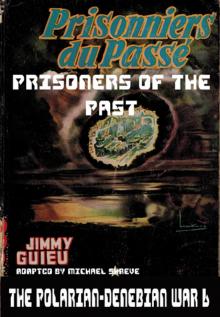 Polarian-Denebian War 6: Prisoners of the Past
Polarian-Denebian War 6: Prisoners of the Past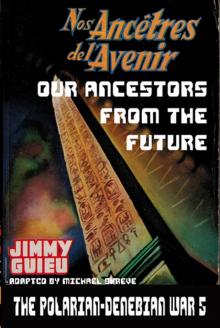 Polarian-Denebian War 5: Our Ancestors From the Future
Polarian-Denebian War 5: Our Ancestors From the Future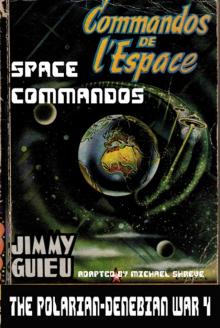 Polarian-Denebian War 4: Space Commandos
Polarian-Denebian War 4: Space Commandos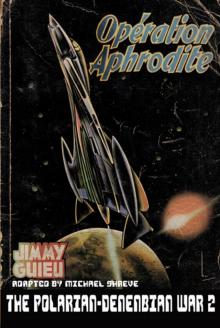 Polarian-Denebian War 2: Operation Aphrodite
Polarian-Denebian War 2: Operation Aphrodite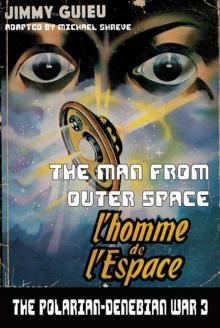 Polarian-Denebian War 3: The Man From Outer Space
Polarian-Denebian War 3: The Man From Outer Space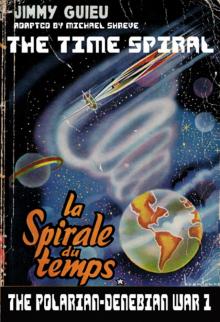 Polarian-Denebian War 1: The Time Spiral
Polarian-Denebian War 1: The Time Spiral